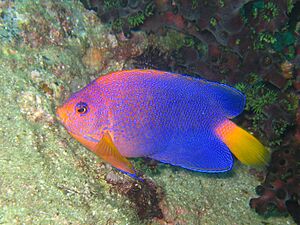Japanese angelfish facts for kids
Quick facts for kids Japanese angelfish |
|
|---|---|
 |
|
| Conservation status | |
| Scientific classification | |
| Synonyms | |
|
The Japanese angelfish (also known as Centropyge interrupta) is a beautiful fish that lives in the ocean. It is a type of marine angelfish and belongs to a family of fish called Pomacanthidae. You can find this colorful fish in the western Pacific Ocean.
Contents
What Does the Japanese Angelfish Look Like?
The Japanese angelfish has a bright orange body. It is covered with pretty purple and blue spots. Its tail is a bright yellow color. The spots get bigger near the tail. The back part of the fish slowly turns purple. The spots also change from blue to purple closer to its tail.
Young Japanese angelfish look a bit different. They have a black spot with a blue edge on their back fin. This spot is called an "ocellus." The back fin has 14 stiff spines and 16 soft rays. The fin on its belly has 3 spines and 17 soft rays. This fish can grow up to 15 centimeters (about 6 inches) long.
Where Does the Japanese Angelfish Live?
The Japanese angelfish lives in the western Pacific Ocean. You can find them in southern Japan, from the city of Tokyo down to Shikoku. They also live around the Izu Islands and the Ogasawara Islands, which are south of Japan.
These fish are also found in waters belonging to the United States. They live around Midway Atoll and Kure Atoll. You can even find them further south near Pearl and Hermes Atoll.
Home and Habits of the Japanese Angelfish
Japanese angelfish live in the ocean at depths between 15 and 60 meters (about 50 to 200 feet). They usually live in pairs. You can find them on rocky reefs. These reefs often have lots of coral and algae growing on them.
What Do They Eat?
The Japanese angelfish eats different things. Their diet includes algae, which are like tiny ocean plants. They also eat small animals that live on the ocean floor. Sponges are another food source for them.
Reproduction and Life Cycle
These fish lay eggs, which means they are "oviparous." They also stay with one partner for life, which is called being "monogamous."
An interesting fact about these fish is that females can change into males. This happens when a female reaches about 12.7 centimeters (5 inches) in length. This change takes about 20 to 39 days to complete.
Japanese Angelfish in Aquariums
The Japanese angelfish is not very common in the aquarium trade. However, they do well when kept in tanks. People have even been able to breed and raise them in captivity. Because they are not common, these fish can be quite expensive to buy for an aquarium.


